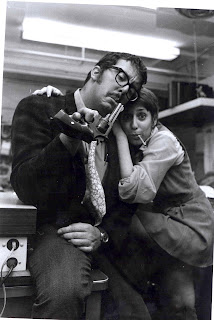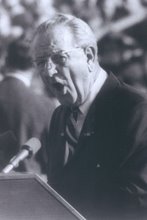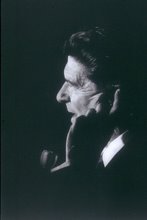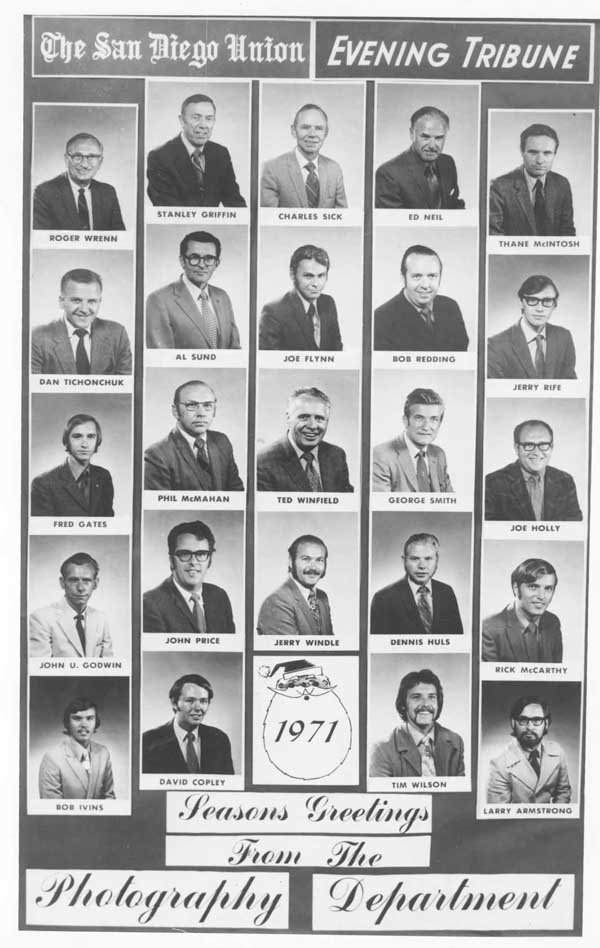
Jack: Here is my reminiscence of hiring on at the UT.
I was an art major in 1967 when we somehow found ourselves in a family way again, which condition we could not afford. I decided to leave school and head back to California and find work but did not want to go back to LA, having gone through the Watts riots and four o’clock traffic on the Hollywood Freeway. So we headed to San Diego where my sister and her husband were in the Navy. About the third day of job hunting, I wandered into 919 cold off the street and talked to Earl Vikander. He took me to talk to Stan Griffin. That was in the days when Stan’s office was in The Annex. You went out the back door of the Trib newsroom on the third floor, past the coffee machines as I recall, and onto the fire escape and back into the building where the presses were. I think they kept the two buildings separate so the noise and vibration from the old Goss letterpresses wouldn’t shake everyone out of their chairs six or eight times a day. Al Sund was in charge of the CNS photo lab in that building and Stan had a desk in the corner. By one of those cosmic coincidences that give life meaning, Stan was looking for a photog that very day and had already decided to hire someone when I walked in. As we talked, I told him that while in high school I had worked as a lab tech and sometimes photographer for the Idaho Falls Post Register and my boss was a remarkable guy named Reed Rasmussen. And in the second coincidence of the day, Stan knew Reed! Stan made a call... Reed lied his head off and Stan hired me on the spot.
I always had the greatest respect for Stan. He was a good and fair boss and always treated me better than I probably deserved. I think I started work at $109 a week which was all the money in the world to a starving ex-student. We had been living on that much a month! Talk about a dream job! And the real joke was on Jim Copely. I would have paid HIM to work for the U-T!
We rented a house on 32nd St in North Park with a date palm in the front yard and thought we had died and gone to heaven. I couldn’t imagine a job that was more romantic and exciting. I used to come into the photo lab on my day off, just to see what was happening. And that was not an uncommon thing for photogs to do in those days.
And as long as I am schlupping around in my memory, here are some other early mental meanderings from my life at the UT... senility is a wonderful thing, ain’t it?
There were, I think, 22 photogs at the time and a great bunch of guys. I don’t think I ever worked with anyone at either 919 or Mission Valley that I didn’t like, photo lab or news side. Most everyone I worked with impressed me with their professionalism and/or their personality and there are a number I still consider my friends.
As the new kid in the photo lab, I always admired the “old timers” like Thane McIntosh, Danny Tichonchuk, Phil McMahan, Roger Wrenn, Jerry Rife, Ted Winfield, John Godwin (you could tell by the crack of the balls when John was shooting pool across the street at the Press Room), Joe Flynn, George Smith and Fred Gates, and all the others. Sorry Fred, but you were there before I was.
I also liked Ed Neil when he wasn’t being a boss. He was a big help when I bought my first boat, a 36 foot steel-hulled Churchward cruiser: “Don’t you know that God never intended boats to be made out of steel? It doesn’t float!” Hmmm, coming from the desert of Idaho, I never thought of that. Ironically, Ed was the one who, on a pleasant evening when I had taken him and Chuck Boyd and several others for a cruise out of Mission Bay, came up from below and asked ingenuously “Are the floor boards down in the cabin supposed to be floating in water?” I am not sure what flashed through anyone else’s mind but PANIC! pretty well covers mine. By then, I had grasped the concept that a steel boat filling up with water was not a good idea in anybody’s book. And I instinctively understood that drowning half the photo staff in one swell foop was probably not going to look good on my resume! During the full-throttle dash back for the breakwater, we discovered that I had left a circulation valve on the engine open and the impending disaster was easily averted by closing it. But the event did leave a serious dent on my ego. Ed kindly never mentioned it.
Jerry Windle and I were heavily into scuba diving together for several years and were partners in a really strange looking dive boat. We did a number of underwater photo spreads in our spare time and on assignment with an underwater camera Charlie Sick bought. Of course, everyone took photos of the “staff seagull”, but I will claim Jerry and I were the only ones to ever photograph the staff lobster.
Joe Holly and I went partners on a 26 foot motor home. A lot of pleasant memories traveling around in it. I learned early on that little kids had a fascination for going to the bathroom at 60 miles an hour and we had to ration it so they wouldn’t fill the holding tank up before we got to Ramona. Another thing that sticks in my mind about Joe is that he was personally acquainted with Evil Knievel from his Montana days? I rode motorcycles for years but preferred to keep my wheels firmly on the ground. I always had serious reservations about the man’s judgement (Evil’s not Joe’s), or lack thereof, but it sure was fun to watch him do his thing. Joe can probably elaborate.
During the seventies, I fell in love with flying and got my pilots license not long after Betty Peach got hers. Although she flew a Beech Bonanza and I flew a lowly Piper 140, we always had good stuff to talk about when we went on assignments together. Thane McIntosh came from an aviation family and I know he could fly a plane, but I don’t recall that he ever got a license? Stan also got me an assignment on the Goodyear blimp once, so I have that in common with both Betty and Chuck Boyd.
Speaking of Chuck, I wanted to finish school and Stan offered to let me work my schedule so that I could go to SDSU (Wasn’t it SDSC then?). However, Chuck was already going to USD so I silently cheered him on for about a year and a half until he graduated and I could go. For the next several years I pretty much went to school in the mornings and worked the 2- to-10 late shift.
One other little UT memory... our son, Steven was born shortly after I joined the photo staff and he had thick black hair that stuck out like a bristle brush. His hair reminded me so much of Joe Flynn’s haircut at the time, that I called him Little Joe, which euphonius appelation stuck solid until after he graduated high school and he changed it back to Steven. He is still “Joe” to the folks who knew him back then.




































